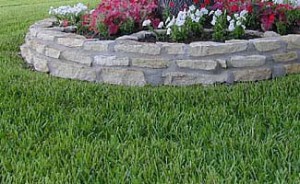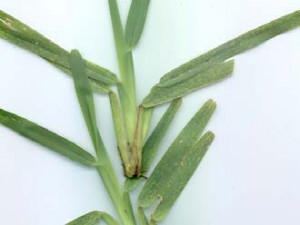 It is August and we are still experiencing drought conditions. As I walk the neighborhood, it is no surprise to find a lot of ugly lawns. Obviously, some of my neighbors have been watering and trying to keep their lawns healthy, while others seem to have given up and accepted the fact that mankind was not really meant to be surrounded by a green carpet of thousands of little high maintenance plants.
It is August and we are still experiencing drought conditions. As I walk the neighborhood, it is no surprise to find a lot of ugly lawns. Obviously, some of my neighbors have been watering and trying to keep their lawns healthy, while others seem to have given up and accepted the fact that mankind was not really meant to be surrounded by a green carpet of thousands of little high maintenance plants.
My biggest surprise has been discovering how the various types have faired. As expected, most fescue looks pretty bad at this time of year, especially those lawns that were planted in the spring. Centipede and Zoysia have held up pretty well when in full sun, and only seem thin and
weak as they experience shade and competition from trees. Bermuda can take the drought but seems to have taken a beating from diseases this year.
The surprise has been St. Augustine. There are several such lawns in my neighborhood and, whether in sun or shade, every one looks great. The days of “St. Augustine just can’t grow well this far north” are long gone and evidence shows we should accept it as an option when planting a new lawn. Sorry Al – the ability to grow St. Augustine has nothing to do with global warming. There are some great new cultivars that have no problem with winter cold and grow well up into North Carolina.
Origin and Distribution: St. Augustine grass is primarily of tropical origin and is native to sandy beach ridges, fringes of swamps and lagoons, salty and fresh water marshes and shorelines. It gradually moved inland to naturally open sites such as stream banks, lakeshores, and other moist sites on the other side of the sand dunes.
 Description: St. Augustine grass, Stenotaphrum secundatum (Walt.) Kuntze, is a perennial robust grass widely used for pastures and lawns. OK, if you want to get technical, it is a coarse textured, stoloniferous species that roots at the nodes. Unlike bermudagrass, St. Augustine grass does not have rhizomes. Its stems (stolons) and overlapping leaf sheaths are generally compressed; leaf blades generally folded, abruptly contracted at the base, rounded at the tip, and smooth; ligule is reduced to a short fringe of hairs; collar is petioled and the sheath greatly compressed and ciliate along the margins.
Description: St. Augustine grass, Stenotaphrum secundatum (Walt.) Kuntze, is a perennial robust grass widely used for pastures and lawns. OK, if you want to get technical, it is a coarse textured, stoloniferous species that roots at the nodes. Unlike bermudagrass, St. Augustine grass does not have rhizomes. Its stems (stolons) and overlapping leaf sheaths are generally compressed; leaf blades generally folded, abruptly contracted at the base, rounded at the tip, and smooth; ligule is reduced to a short fringe of hairs; collar is petioled and the sheath greatly compressed and ciliate along the margins.
Adaptation and Use: St. Augustine grass is adapted to moist, coastal areas with mild winter temperatures. It is known to be tolerant of high summer temperatures, and retains its color at temperatures as much as 10° lower than those that discolor bermudagrass. Varieties and Cultivars: Since St. Augustine grass has been propagated vegetatively for 200 years. Only a few strains or varieties have evolved and none have been developed through grass breeding programs. Of the warm-season grasses, it exhibits the best tolerance to shade. Recommended St. Augustine grass cultivars for the Atlanta area include Raleigh, Palmetto and Mercedes.
Propagation: St. Augustine grass is propagated by vegetative means — stolons, plugs or sod. Propagation by seed has potential, but we are just not there yet. It is readily established from sod since the species is vigorous and spreads rapidly by creeping stolons. Sod plugs or stolons planted on 1 to 2 foot spacing can be expected to cover in one growing season. In typical lawn plantings, 2 to 4 square inch sod plugs are planted on 1 to 2 foot spacing. This grass can be successfully established from plugs anytime during the growing season if water is available.
Management: After establishment the success of SA as a lawn grass depends largely on management. Mowing, fertilization and supplemental watering are required to maintain a dense, green, weed-free turf. Mowing heights may range from 1 to 3 inches depending on the frequency of mowing and the degree of shade present. Go easy on the fertilizer. St. Augustine grass is responsive to nitrogen fertilizer in terms of color and growth rate. On sandy soils this grass requires about 1 pound of nitrogen per 1,000 square feet per month during the growing season to maintain satisfactory color and density. So long as fertility and drainage are adequate, St. Augustine grass tolerates a wide range of soil types. St. Augustine grass grows satisfactorily at a pH range from 5.0 to 8.5
Insects and Diseases: Several insect pests can cause damage to St. Augustine grass lawns. Fortunately, the dreaded chinch bug isn’t a problem north of Macon, Ga. We do have white grubs that can feed on SA during the summer months. Sod webworms, armyworms and cutworms can also feed on leaves and can cause damage when infestations are heavy. All of the leaf-feeding insects can be easily controlled by insecticides or possibly BT. Brown patch and gray leaf spot are the most serious diseases caused by fungi attacking St. Augustine grass. Although these diseases rarely kill St. Augustine, they can weaken and thin the grass to the degree that the lawn is unsightly.
Weeds: A healthy St. Augustine lawn effectively crowds out most weeds. If is not properly maintained or is weakened by insects or disease, it can be invaded by grassy and broadleaved weeds. Cool season weeds such as henbit, chickweed and clover can be a problem in dormant St. Augustine grass. These weeds can be controlled with commonly available herbicides in early spring.
As possibly the laziest gardener in Gwinnett County, I am always on the lookout for grass, shrubs, and trees that will perform consistently well with as little care from me as possible. The last two summers have convinced me that St. Augustine is now a viable option for North Georgia. As I watch my last green blade of fescue start to fade to yellow (after about a million gallons of water), I am already making plans to plant St. Augustine in the spring.
